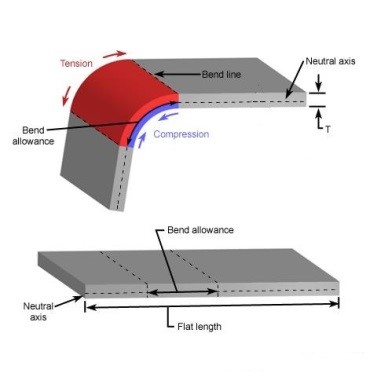This distortion is termed springback.
Springback in bending of sheet metals and plates.
Figure 3 coining bottom bending and air forming affect stressstrain properties differently.
While sheet metal gauges run from 0 005 to 0 249 inch thick aluminum and steel plate thicknesses start at 0 250 in.
It can be can be understood by looking at a material s stress stain curve discussed in the module on tensile testing which characterizes the behavior of metal under applied force.
This is done through the application of force on a workpiece.
And go all the way up to 13 in.
Bending is one of the most common sheet metal fabrication operations.
The springback can be reduced by the way that the deformation of plate exceeds the theoretical deformation degree.
2 the stainless steel sheet has a strong rebound tendency compared with carbon steel when bending.
Sheet metal bending bending of sheet metal is a common and vital process in manufacturing industry.
Bending is one of the most frequent actions done to metal in press brake operation.
After a bending operation residual stresses will cause the sheet metal to spring back slightly.
The force must exceed the material s yield strength to achieve a plastic deformation.
This springback and inside radius calculator estimates the amount of angular change and the relaxing of bend radius that occurs when metal is bent and released from pressure when the proportional limits of a specific material are reached or exceeded the material remains bent figure one.
Also known as press braking flanging die bending folding and edging this method is used to deform a material to an angular shape.
The curved line in the air forming zone shows how springback changes at different bend angles.
3 the percentage of elongation of stainless steel plate is lower than the carbon steel the bending angle of the workpiece r is larger than that of carbon steel or there is the possibility of cracks.
Sheet metal bending is the plastic deformation of the work over an axis creating a change in the part s geometry.
When it comes to very thick or high tensile strength material.
The formation of sheet metal requires elastic plastic bending and stretching of the metal which contributes to springback.
In bending production the deformation angle and radius of sheet metal will be increased due to elastic recovery.
A depiction of springback in a simple bend can be seen in figure 1.
Likewise plate steel varies in strengths from mild varieties to some very high strength materials such as hardox.
Springback is known as the reaction when this metal is bent and causes complications when forming the metal into objects such as seams.
In bottoming and coining bending methods that usually produce 90 degree bend angles the line curves to the right of the vertical axis showing how the metal springs forward to conform to the die angle.

